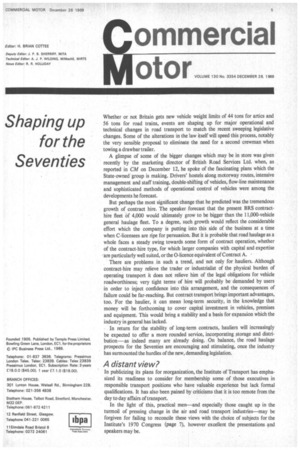Whether or not Britain gets new vehicle weight limits of
Page 7

If you've noticed an error in this article please click here to report it so we can fix it.
44 tons for artics and 56 tons for road trains, events are shaping up for major operational and technical changes in road transport to match the recent sweeping legislative changes. Some of the alterations in the law itself will speed this process, notably the very sensible proposal to eliminate the need for a second crewman when towing a drawbar trailer.
A glimpse of some of the bigger changes which may be in store was given recently by the marketing director of British Road Services Ltd. when, as reported in CM on December 12, he spoke of the fascinating plans which the State-owned group is making. Drivers' hostels along motorway routes, intensive management and staff training, double-shifting of vehicles, flow-line maintenance and sophisticated methods of operational control of vehicles were among the developments he forecast.
But perhaps the most significant change that he predicted was the tremendous growth of contract hire. The speaker forecast that the present BRS contracthire fleet of 4,000 would ultimately grow to be bigger than the 11,000-vehicle general haulage fleet. To a degree, such growth would reflect the considerable effort which the company is putting into this side of the business at a time when C-licensees are ripe for persuasion. But it is probable that road haulage as a whole faces a steady swing towards some form of contract operation, whether of the contract-hire type, for which larger companies with capital and expertise are particularly well suited, or the 0-licence equivalent of Contract A. • There are problems in such a trend, and not only for hauliers. Although contract-hire may relieve the trader or industrialist of the physical burden of operating transport it does not relieve him of the legal obligations for vehicle roadworthiness; very tight terms of hire will probably be demanded by users in order to inject confidence into this arrangement, and the consequences of failure could be far-reaching. But contract transport brings important advantages, too. For the haulier, it can mean long-term security, in the knowledge that money will be forthcoming to cover capital investment in vehicles, premises and equipment. This would bring a stability and a basis for expansion which the industry in general has lacked.
In return for the stability of long-term contracts, hauliers will increasingly be expected to offer a more rounded service, incorporating storage and distribution—as indeed many are already doing. On balance, the road haulage prospects for the Seventies are encouraging and stimulating, once the industry has surmounted the hurdles of the new, demanding legislation.
A distant view?
In publicizing its plans for reorganization, the Institute of Transport has emphasized its readiness to consider for membership some of those executives in responsible transport positions who have valuable experience but lack formal qualifications. It has also been pained by criticisms that it is too remote from the day to day affairs of transport.
In the light of this, practical men—and especially those caught up in the turmoil of pressing change in the air and road transport industries—may be forgiven for failing to reconcile these views with the choice of subjects for the Institute's 1970 Congress (page 7), however excellent the presentations and speakers may be.












































































